
Invertebrate animals are those that do not have a backbone. The majority of the world's animals are found in this group, representing 95% of the existing species. Being the most diverse group within this kingdom, its categorization has become very difficult.
In this AnimalWised article we're going to explain the most common classification of invertebrates. We include definitions, characteristics, examples and charts. Continue reading to learn more!
Definition of invertebrate animals
Invertebrate animals are those that do not have a backbone. The majority of the world's animals are found in this group, representing 95% of the existing species. Being the most diverse group within this kingdom, its categorization has become very difficult. This is why there are no definitive classifications as the scientific community continues to make new identifications on a regular basis. With that being said, let's take a look at the most common classification of invertebrate animals.

How are invertebrate animals classified?
As with other animals, the classification of invertebrates are not set on stone as many new discoveries are still taking place. With that being said, there is some consensus that the main groups of invertebrates can be classified in the following phyla:
- Arthropods.
- Mollusks.
- Annelids.
- Platyhelminthes.
- Nematodes.
- Echinoderms.
- Poriferous.
- Cnidarias.
Classification of arthropods
Arthropods are animals with a well-developed organ system, characterized by the presence of an exoskeleton formed by chitin. In addition, they have differentiated and specialized appendices for various functions depending on the group.
The arthropod phylum corresponds to the most extensive group in the animal kingdom and is classified into four subphiles:
- Trilobites (all extinct)
- Chelicerates
- Crustaceans
- Unirrámeos
Let's take a look into the groups that are not extinct:
Chelicerates
In these, the first two appendices have been modified to form chelicerae. In addition, they have pedipalps, four pairs of legs and do not have antennae. They are made up of the classes:
- Merostomates: they have the absence of pedipalps, but the presence of five pairs of legs, such as the pan crab ( Limulus polyphemus ).
- Pycnogonids: marine animals with five pairs of legs that are commonly known as sea spiders.
- Arachnids: they have tagmas, chelicerae, pedipalps that are not always well developed and four pairs of legs. These include spiders, scorpions, ticks, and mites.
Crustaceans
These are generally aquatic and with the presence of gills, antennae and jaws. They are made up of five representative classes, among which are:
- Remipedios: they are blind and live in deep sea caves, like the Speleonectes tanumekes species.
- Cephalocarids: they are marine, small in size and simple in anatomy.
- Branchiopods: small to medium in size, they mainly inhabit fresh waters, but also salty ones. They have posterior appendices. In turn, they are made up of four orders: anostraceous (where we can locate goblin shrimp such as Streptocephalus mackini), notostraceous (called tadpole shrimp, such as Artemia franciscana), cladocerans (which are water fleas) and concostraceous (the clam shrimp, such as Lynceus brachyurus).
- Maxilopods: generally small in size and with reduced abdomen and appendages. They are subdivided into ostracods, mystacocarids, copepods, tantulocarids, branquiurus and barnacles.
- Malacostráceans: the crustaceans best known to humans are located, they have an articulated exoskeleton that is relatively softer and are made up of four orders, among which are isopods (Ex. Armadillium granulatum), amphipods (ex. Alicella gigantea), the eufausiaceae, which are generally known as krill (ex. Meganyctiphanes norvegica) and the decapods, among which we find crabs, shrimp and lobsters.
Sub-phylum
These are characterized by the fact that all the appendages they have are single branch or axis and have antennae, mandibles and maxillae. This sub-phylum is made up of five classes:
- Diplopods: characterized by generally having two pairs of legs in each of the segments that make up the body. In this group we find millipedes, such as the species Oxidus gracilis.
- Chilopods: they have twenty-one segments, in which there are a pair of legs in each one. This group is commonly called centipedes (Lithobius forficatus, among others).
- Pauropods: small in size, soft bodies and with up to eleven pairs of legs.
- Symphony: whitish in color, small and fragile.
- Insect class: they present a pair of antennae, three pairs of legs and generally wings. It is an abundant class of animals that groups almost thirty different orders.
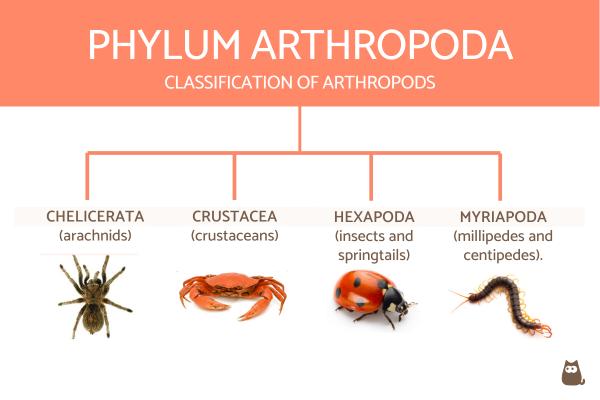
Classification of mollusks
This group is characterized by having a complete digestive system, with the presence of an organ called radula, which is located in the mouth and has a scraping function.
They have a structure called the foot that can be used for locomotion or fixation. Their circulatory system is almost all open, gas exchange is carried out through gills, lungs or the surface of the body and the nervous system varies according to the group. They are divided into eight classes:
- Caudofoveados: marine animals that dig the soft ground. They lack a shell but have calcareous spicules, such as Falcidens crossotus.
- Solenogastros: like the previous class, they are marine, burrowing and with calcareous structures. However, they lack radula and gills (eg Neomenia carinata).
- Monoplacophores: they are small, with a rounded shell and ability to crawl thanks to the foot, (eg Neopilina rebainsi).
- Polyplatecophores: these are elongated, flattened bodies and with the presence of a shell. It forms chitons, like the species Acanthochiton garnoti.
- Scaphopods: its body is enclosed in a tubular shell with opening at both ends. They are also called dentalia or tusk shell. An example is the species Antalis vulgaris.
- Gastropods: with asymmetric shapes and the presence of a shell, which has suffered the effects of torsion, but which may be absent in some species. The class is made up of snails and slugs, such as the snail species Cepaea nemoralis.
- Bivalves: the body is inside a shell with two valves that can have different sizes. An example is the Venus verrucosa species.
- Cephalopods: their shell is quite reduced or absent, with a head and defined eyes and the presence of tentacles or arms. In this class we find octopus and squid.
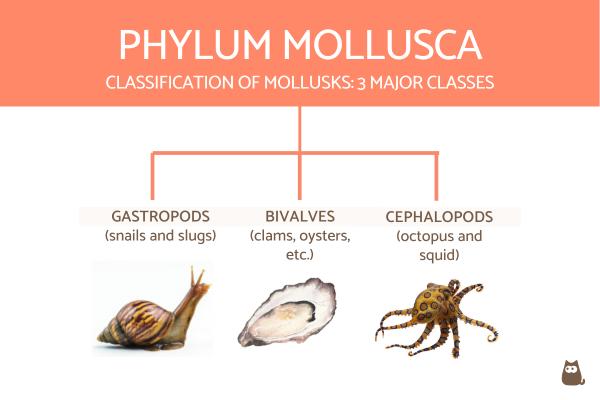
Classification of annelids
These are metameric worms, that is, with segmentation of the body, with external moist cuticle, closed circulatory system and complete digestive system, the gas exchange is through gills or the skin and they can be hermaphroditic or with separate sexes.
The highest classification of annelids is made up of three classes:
- Polychaetes: mainly marine, with a well differentiated head, presence of eyes and tentacles. Most of the segments have lateral appendages. We can mention as an example the species Nereis succinea and Phyllodoce lineata .
- Oligochaetes: they are characterized by presenting variable segments and without a defined head. We have for example to the earthworm ( Lumbricus terrestris ).
- Hirudíneos: as an example of hirudíneos we find leeches (eg Hirudo medicinalis), with a number of fixed segments, presence of many rings and suckers.
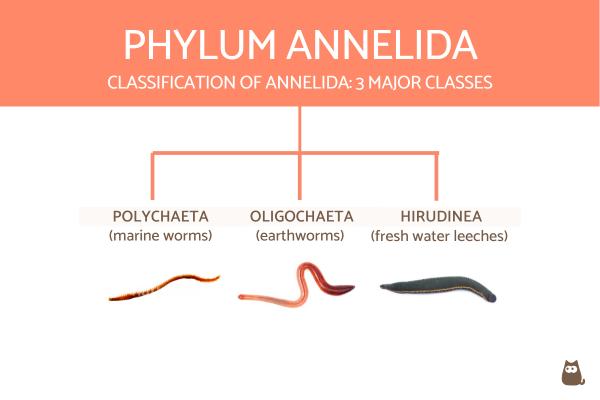
Classification of platyhelminthes
Platyhelminthes are dorsoventrally flattened animals, with oral and genital opening and a primitive or simple nervous and sensory system. In addition, they lack a respiratory and circulatory system.
They are divided into four classes:
- Turbellarians: these have a free life form, being able to measure up to 50 cm, with epidermis formed by cilia and with the ability to crawl. They are commonly known as planarians (ex. Temnocephala digitata).
- Monogeneans: They are mainly parasitic forms of fish and some of frogs or turtles. They are characterized by having a direct biological cycle, with a single host (ex. Haliotrema sp.).
- Trematodes: its body is leaf-shaped, characterized by being parasitic forms. In fact, most are endoparasites of vertebrates (ex. Fasciola hepatica).
- Cestodes: with characteristics that differ from the previous classes, they have long and flat bodies, lacking cilia in the adult form and the digestive tube. However, it is covered with micro villi that thickens the tegument or the covering of the animal (ex. Taenia solium).
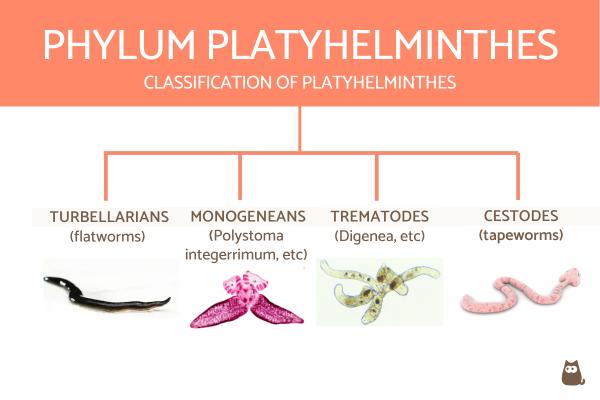
Classification of nematodes
Small parasites that occupy marine, freshwater and soil ecosystems, both in polar and tropical regions, being able to parasitize other animals and plants. There are thousands of identified species and they have a characteristic cylindrical shape, with a flexible cuticle and the absence of cilia or flagella.
The following is a classification based on the morphological characteristics of the group and corresponds to two classes:
- Adenophorea: their sensory organs are circular, spiral, or pore-shaped. Within this class we can find the parasitic form Trichuris trichiura.
- Secernentea: these have dorsal lateral sensory organs and cuticle formed by several layers. In this group we place the parasitic species Ascaris lumbricoides.

Classification of echinoderms
These are marine animals that do not present segmentation. Its body has a rounded, cylindrical or star shape, without a head and with a varied sensory system. They present calcareous spicules, with locomotion by different routes.
This phylum is divided into two subphiles: Pelmatozoa (cup- or calyx-shaped) and Eleutherozoans (stellate, discoidal, globular or cucumber-shaped body).
Pelmatozoa
This group is made up of the crinoid class, where we find those commonly known as sea lilies, and among which we can mention the species Antedon mediterranea, Davidaster rubiginosus and Himerometra robustipinna among others.
Eleutherozoans
In the second sub-phylum there are five classes:
- Concentricycloids: known as sea daisies (ex. Xyloplax janetae).
- Asteroids: or starfish (ex. Pisaster ochraceus ).
- Ophiuroids: which includes the ophiuras (ex. Ophiocrossota multispina ).
- Echinoids: commonly known as sea urchins (ex. S trongylocentrotus franciscanus and Strongylocentrotus purpuratus).
- Holothuroids: also called sea cucumbers (ex. Holothuria cinerascens and Stichopus chloronotus).

Classification of cnidarians
These are characterized by being mainly marine and there are few freshwater species. There are two types of forms in these individuals: polyps and jellyfish. They have a chitinous, calcareous or protein exoskeleton or endoskeleton, with asexual or sexual reproduction and they lack a respiratory and excretory system. A characteristic of the group is the presence of stinging cells that they use to defend or attack the prey.
The cutting edge has been divided into four classes:
- Hydrozoans: have an asexual life cycle in the polyp phase and sexual in the jellyfish phase, however, some species may lack one of the phases. Polyps form fixed colonies and jellyfish can move freely (ex. Hydra vulgaris).
- Scifozoans: this class generally includes large jellyfish, with bodies of various shapes and different thicknesses, which is formed by a gelatinous layer. Its polyp phase is very small (ex. Chrysaora quinquecirrha).
- Cubozoa: predominantly jellyfish, some reach great heights. They are very good swimmers and hunters, and certain species can be lethal to humans, while some have mild poisons (ex. Carybdea marsupialis).
- Anthozoans: they are flower-shaped polyps, without a medusa phase. All are marine, being able to live in a superficial or deep way and in polar or tropical waters. It is divided into three subclasses, which are aoantarios (the anemones), ceriantipatarios and alcionarias.
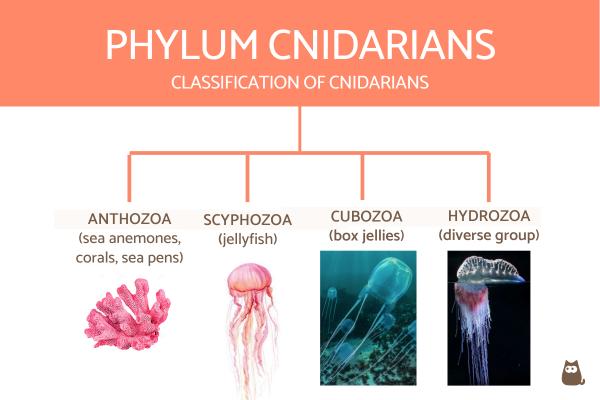
Classification of poriferas
Sponges belong to this group, the main characteristic of which is that their bodies have a large number of pores and a system of internal channels that filter food. They are sessile and rely heavily on water to circulate through them for food and oxygen. They lack real tissue and therefore organs.
They are exclusively aquatic, mainly marine, although there are some species that inhabit fresh waters. Another fundamental feature is that they are made of calcium carbonate or silica and collagen.
They are divided into the following classes:
- Calcareas: in which their spicules or units that form the skeleton are of calcareous origin, that is, of calcium carbonate (ex. Sycon raphanus).
- Hexactinellids: also called vitreous, which have the particular characteristic that their skeleton is rigid and is made up of six-ray spicules of silica (ex. Euplectella aspergillum).
- Demosponjas: class in which almost 100% of the species of sponges and those of greater size are located, presenting very striking colors. The spicules that form them are made of silica, but not six-ray (ex. Xestospongia testudinaria).
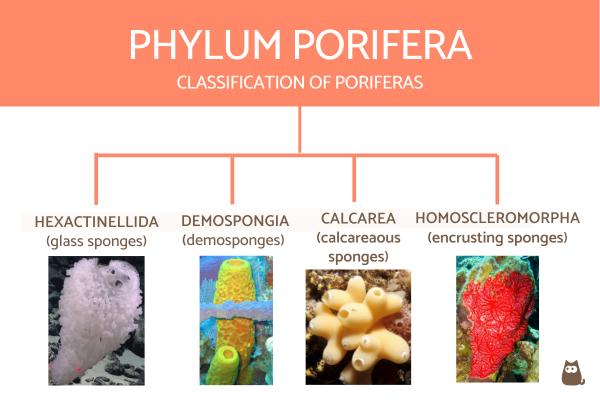
Other invertebrates
As we have mentioned, this group of animals is very abundant and there are other phyla that are included within the classification of invertebrate animals. Some of them are:
- Placozoans.
- Ctenophores.
- Chaetognatha.
- Nemertines.
- Gnathostomulids.
- Rotifers.
- Gastrotics.
- Kinorrincos.
- Loricifers.
- Priapulids.
- Nematomorphs.
- Endoprocts.
- Onychophores.
- Tardigrades.
- Ectoprocts.
- Brachiopods.
As we could see, the classification of invertebrate animals is highly abundant, and with the passage of time, the number of species that make it up will surely continue to grow, which shows us once again how wonderful the animal world is. Want to learn more about invertebrate animals? Watch the video below!

If you want to read similar articles to Classification of Invertebrates Chart With Definitions and Examples, we recommend you visit our Facts about the animal kingdom category.
- Curtis, H., Barnes, N., Schnek, A., Massarini, A. (2008). Biology Editorial Médica Panamericana. Madrid.
- Hickman, C., Roberts, L., Parson A. (2000). Comprehensive principles of zoology . McGraw Hill Interamericana: Spain.
- Vielma, H. (2013). The world of biology . Polar Foundation. Venezuela. Available at: https://bibliofep.fundacionempresaspolar.org/media/16994/libro_mundo_biologia_lw_14.pdf